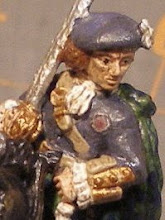On Monday, Sep 1, 2014 (Labor Day here in the US), several of us gathered to test the newly released reprint (and update) of "On to Richmond" rules for the American Civil War.
These rules were originally published in the now defunct "The Courier" magazine and as a separate rule booklet. They use the infantry or cavalry brigade as the basic maneuver element supported by artillery battalions of 12 guns. Each stand is either 300 infantry or 200 cavalry and the brigades are made up of between 3 to 8 stands.
I decided since it was the 150th anniversary of the first day (Aug 31) of the battle of Jonesborough, Georgia, the culmination of the Atlanta campaign, to use it as the test run. In the battle, two Confederate corps, Hardee's and S.D. Lee's, both under Lt Gen Hardee's command, attacked the Army of the Tennessee under Maj Gen O.O. Howard. There were two Union corps in the first line and a third in reserve. Each of the five players commanded a corps of two to three divisions.
It took us a while for me to go through the rules since we had never played them before. The Confederates set up as they had done historically with Hardee's Corps (under Cleburne) on the left and Lee's Corps on the right. But when they saw the Union deployment in hasty defensive works they tried to alter their attack by moving the their left. That took up a goodly period of physical time so we only got to play two or three turns. By then it was apparent that the Confederates weren't going to push the Union forces back so everyone agreed that it was a draw. Historically on August 31, the Confederates launched vigorous attacks against the Union forces and suffered severe casualties without dislodging the Union from their positions to any great degree. Then overnight, Gen Hood got worried about the safety of Atlanta and recalled Lee's Corps, leaving Hardee alone on Sep 1 to face both the Army of the Tennessee and the Army of the Cumberland. Hardee resisted for a while but was forced to withdraw from Jonesborough, allowing the Union to completely cut the last rail line into Atlanta. Gen Hood withdrew the Army of Tennessee on Sep 2 and the Union forces then marched into Atlanta.
I only took a few pictures as I was trying to help several of the players understand the play sequence and the maneuvering of their commands. We used my friend Jay's vintage 25mm ACW forces which are organized with regiments as the basic maneuver unit. They got "promoted" to brigades for this battle. The Union had 6 stands per infantry brigade while the understrength Confederate brigades only had 4 stands. Even so, the forces were about equal since several Union divisions of the Army of the Tennessee were elsewhere that day.
 |
| Looking north behind the Union behind Maj Gen Logan's XV Corps. There seems to be a visitor to the battlefield. I wonder if he had anything to do with the Union victory? |
COMMENTS: Now, what did we think of the rules. Personally I liked them, even though I didn't actually move any troops. The other players indicated that they would like to try them again, but I think there will be some changes made (i.e., "home" rules). One thing we didn't like was having to roll a die to see if one could enter or pass through disruptive terrain. Sean (playing Logan) had one of his brigades trapped in the woods even though the other brigade of that division was able to get out and advance. He also tried to roll to remove some disruptions from one of his brigades that was in the hasty defenses. Unfortunately he rolled too high and they charged out and across a field to get at the artillery that had been firing on them. [EDIT: I missed the statement on the morale table that units in works, etc. can ignore advance results.] I think we'll make to modifications to those procedures to allow units a little easier time getting out of some woods (but some may be just be too heavy for them to easily traverse)










No comments:
Post a Comment